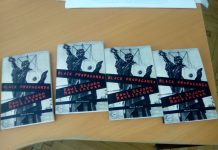UK publishing house Arc Publications has been in business since 1969, almost all of those years spent in the northern town of Todmorden (pictured above), on the border between Yorkshire and Lancashire.
 From this ruggedly independent location, it “publishes contemporary poetry from new and established writers from the UK and abroad, specialising in the work of international poets writing in English and the work of overseas poets in translation.”
From this ruggedly independent location, it “publishes contemporary poetry from new and established writers from the UK and abroad, specialising in the work of international poets writing in English and the work of overseas poets in translation.”
I recently spoke to Ben Styles, editorial assistant and the man “responsible for Arc’s move into ebook publishing, designing and converting new and backlist titles into Kindle and ePub formats,” about Arc’s take on poetry e-publishing and the UK market as a whole.
* * *
TeleRead: What is Arc’s take on the situation for e-book publishing of poetry in the UK? How well suited are e-books to poetry, and how is the audience responding to them?
Styles: For a while now, and with good reason, I think readers have been wary of poetry e-books. Publishers have been slow to take full advantage of the e-book format for the successful layout of poetry, and consequently many readers have been disappointed with the poetry e-books they have bought in comparison with their print equivalents.

Of course I only have anecdotal evidence to support this observation—e-book market research is difficult to come by, especially regarding poetry—but it seems to be borne out by our own research. I myself have seen problems such as a lack of page breaks, typographic inconsistency, a lack of hanging indents for lines that run over, even a bilingual text in which the original language and the English are muddled together—all in poetry e-books that have been purchased on Amazon and other webstores.
No publisher would settle for such errors in print, so why should they in e-books?
We believe e-books are—can be—eminently suited to poetry, but it requires certain specialist practices to make this true, and these are only starting to appear on the market. There are several techniques we are using that we haven’t seen elsewhere yet, and hopefully this, along with a general increase in quality, will encourage people to try poetry out. I see it as very similar to the growth of the Internet. At the start, when we were all using Internet Explorer and that awful AOL browser, the Internet was essentially ugly. The nicer it gets to use, the more people want to use it. We want to do for poetry e-books what the Internet pioneers did for websites.
TeleRead: Does e-publishing of poetry help promote more original and unusual work, such as modern poetry in translation?
Styles: There are two ways of approaching this question. In one sense, e-books are just another format—like paperback, hardback, press galley, or PDF scan. If you look at modern poetry in translation specifically, however, and the work of Arc Publications among others, I think e-books present the opportunity for a leap forward.
We publish poets from all over the world, and it is one of our principal goals to bring the best writers in other languages to a global anglophone audience. This can be hampered by the logistics and the costs of sending heavy boxes of books to distant countries, but e-books bypass all of that.
Logistically, e-books help us enormously in promoting fantastic but often not widely known work to new readers.
TeleRead: How do e-books fit into your own publishing schedule? Do you, or will you eventually, publish all your books in e-book editions too?
Styles: Absolutely. E-books are now a principal part of our publication process. As well as committing to publish all our current and future titles in e-book edition (where rights allow), we are working on converting as many of our backlist titles as humanly possible.
TeleRead: What approach do you take to formatting your poetry e-books? Do you have to use any special formatting techniques?
Styles: Our approach is always to match the print edition as closely as possible, while taking full advantage of the functionality afforded by e-books and e-reader devices. There are of course exceptions, but in most cases poetry e-books require more time to format than prose because there are certain techniques that we see as essential for a successful digital rendition of poetry. Unfortunately, many big publishers of poetry are still releasing e-books that don’t match these basic requirements. They are:
• Hanging indents, so that when the reader increases the font size on their device and lines run over, it is still clear where each line of verse starts and ends
• Clear typographical differentiation between poem titles and body text
• Justifying prose text, to make the distinction between verse and prose clear
• Surviving user intervention: images and indents resize proportionally across different screens
• Two tables of contents: one accessible from the device menu, and another laid out typographically within the e-book as in the print edition, offering the reader the greatest choice.-
• Non-breaking spaces to prevent dashes and other symbols at the end of lines running over and floating between lines.
• And many more…
In addition, most of our e-books are bilingual, and this requires further specialized formatting, including:
• Crosslinks between languages, so the reader can flick easily between original language and English translation.-
• Graceful degradation for e-books that contain embedded foreign scripts (Tamil, for example) on devices that cannot display embedded fonts
• Clear, two-column tables of contents
TeleRead: Is there any difference in your approach to poetry e-books as an independent publisher? Do you have severe resource constraints compared to a major house?
Styles: Being an independent publisher always means resource constraints are a part of daily life, but it also allows us a huge amount of freedom. We have been able to ensure that e-book conversion remains in-house, so we know exactly what we are putting into our customers’ hands. E-books lack the printing and distribution costs of print editions, and we have developed a publication workflow that allows us to create print proofs and e-books side-by-side, so incorporating digital publishing into Arc’s output has been relatively painless and will certainly be worth the extra expense.


































